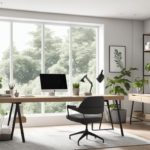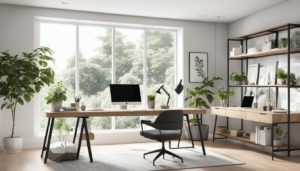
How Big Should a Home Office Be? – An Essential Factor
As more and more people are working from home, designing a functional home office has become a top priority. The size of your home office is an essential factor to consider to create a comfortable and productive workspace that meets your needs. But how big should a home office be?
The ideal dimensions for a home office depend on several factors, including the type of work you do, available space in your home, and the furniture you have or plan to purchase. In the following sections, we’ll explore the factors to consider when determining the ideal size for your home office, including productivity, comfort, ergonomics, and storage. We’ll also provide tips for optimizing your office layout, selecting the right furniture, and designing a multi-functional workspace.
 Key Takeaways:
Key Takeaways:
- The size of your home office should be determined by the type of work you do, available space, and furniture requirements.
- The ideal workspace dimensions should optimize productivity and comfort while adhering to ergonomic principles.
- Adequate storage is essential for maintaining a clutter-free workspace.
- You can create a multi-functional workspace by designing a flexible layout and selecting furniture that serves multiple purposes.
- The size of your home office has a significant impact on your overall work-from-home experience, so it’s essential to choose the right dimensions.
Factors to Consider for Your Home Office Size
Designing a home office requires careful thought and consideration, especially when it comes to determining the size of your workspace. “Determining home office space” involves assessing your needs and available space to ensure a functional and comfortable workspace.
When deciding on your office space requirements, you need to consider various “home office design guidelines.” These guidelines may vary depending on your industry, but they often include factors such as lighting, noise levels, and safety requirements.
In addition, you’ll need to consider the type of work you do as it will largely dictate the amount of space you require. For instance, if you need multiple pieces of equipment or have frequent client meetings, you may need a larger workspace.
A crucial step in determining your home office size is assessing the available space in your home. Take accurate measurements of the potential workspace areas and create a floor plan to visualize how the office will fit into the available space.
Lastly, it’s essential to consider “office space requirements” based on ergonomic principles. Your workspace should be comfortable and conducive to productivity. For example, you need enough floor space to accommodate your chair and desk, and the room should have adequate ventilation to promote healthy indoor air quality.
Factors to Consider for Your Home Office Size
| Factors | Description |
|---|---|
| Type of work | Determine the amount of space required based on work equipment, client meetings, and the level of privacy needed. |
| Available space | Take accurate measurements of the available space, create a floor plan, and ensure there’s enough room for adequate ventilation and comfortable movement. |
| Home office design guidelines | Familiarize yourself with industry-specific regulations regarding safety, lighting, noise levels, and general office design. |
| Ergonomic principles | Design your workspace based on ergonomic principles, ensuring your posture, eye levels, and keyboard and mouse height are conducive to overall comfort and productivity. |
By considering the above factors, you can determine the “ideal home office dimensions” for your specific needs while creating a comfortable, productive, and visually appealing workspace.
The Importance of Productivity and Comfort
As someone who works from home, I know how important it is to create a workspace that promotes productivity and comfort. After all, our home office is where we spend a significant amount of time each day. While designing your home office, it’s crucial to get the right dimensions to achieve a balance between productivity and comfort.
The ideal home office dimensions will vary based on your specific requirements. Consider the type of work you do, the equipment you use, and the available space in your home. Calculating home office dimensions involves finding the optimal office size to fit your needs while ensuring that the space is comfortable and efficient.
To achieve the right balance of productivity and comfort, it’s crucial to choose an optimal office size that suits your needs. A cramped workspace can impact your productivity, while a large, open space can make it challenging to focus. The optimal home office size will allow you to work efficiently and create a comfortable environment that promotes focus and productivity.
When determining the ideal home office dimensions, consider the furniture layout and the equipment you need. Ergonomics plays a critical role in setting up an efficient workspace, and the layout of your furniture should support your posture and working habits. By optimizing the layout of your furniture and integrating ergonomic principles, you can create a space that minimizes discomfort and promotes a healthy working environment.
Overall, finding the ideal home office dimensions is a balance between maximizing productivity and creating a comfortable working environment. By considering the factors that affect your workspace, you can determine the optimal office size that suits your needs and helps you work efficiently while preserving your comfort.
Ergonomics and Space Planning
When designing a home office, it’s essential to consider ergonomic principles. Ergonomics refers to the science of designing the workspace to minimize physical stress and strain on the body. Poorly designed workspaces can lead to physical discomfort, fatigue and even long-term injuries.
One of the crucial aspects of ergonomics is space planning. With the right planning, you can optimize your workspace to promote comfort and increased productivity. One of the primary factors to consider is the square footage of your home office.
The ideal home office dimensions should provide enough space to move around freely and accommodate all the necessary equipment and furniture. The amount of space you need will depend on your specific work requirements.
To determine the ideal home office square footage, use the following guidelines:
- For a basic home office setup: Aim for at least 50 square feet of space per person.
- For larger workstations: Increase the square footage to a minimum of 100-150 square feet.
- For multi-purpose home offices: Ensure the total square footage accommodates the additional function.
Remember that these guidelines are just a starting point. You should also consider the layout of your home office and the type of work you do. A cramped workspace can significantly impact your productivity and physical well-being.
Once you have determined the ideal square footage, it’s time to consider the furniture layout and design elements that will contribute to your office’s productivity and comfort.
Layout and Furniture Considerations
When planning your home office size and layout, it’s important to consider the furniture you’ll need and how to arrange it for optimal functionality. Here are some tips for choosing furniture and organizing your workspace to make the most of your office size.
Consider Your Work Needs
Think about the type of work you’ll be doing in your home office to determine the furniture pieces you’ll need. For example, if you need to meet with clients, you’ll need a comfortable seating area and a table or desk to host meetings. On the other hand, if your work requires a lot of storage space, you’ll need bookshelves, cabinets, and other storage furniture to keep your files and supplies organized.
Choose Furniture that Fits
When selecting furniture for your home office, make sure it fits the dimensions of your workspace. Oversized furniture will make your workspace feel cramped, while furniture that is too small may be uncomfortable or inefficient. Consider purchasing furniture that is specifically designed for home offices, as it will be tailored to fit the needs of a smaller workspace.
Create an Efficient Layout
The layout of your home office can impact its overall size and functionality. To make the most of your workspace, arrange your furniture to create a functional flow. Place your desk in a location that will provide the most natural light and free space for movement. Consider leaving some open wall space to free up floor space and create a more relaxed atmosphere.
Stay Organized
Having an organized workspace will help you stay productive and efficient. Consider using organizational tools like desktop organizers, filing cabinets, and shelves to keep your workspace clutter-free. Keep the items you use most often within easy reach, and make sure to sort through papers and files regularly to minimize clutter.
Storage Solutions for a Home Office
A well-organized home office can boost productivity and help you stay on top of your workload. However, storing all your office supplies and equipment can be a challenge, especially when you have limited space. Here are some clever storage solutions that can help you maximize your office space while keeping it clutter-free.
1. Invest in Multi-functional Furniture
When space is limited, multi-functional furniture can be a lifesaver. Look for desks with built-in drawers and shelves to keep your supplies close at hand. You can also consider bookshelves or cabinets that double as room dividers, separating your office from other living areas while providing storage space.
2. Utilize Wall Space
If you have limited floor space, consider using your walls for storage. Install shelves and cabinets above your desk to keep items within reach. You can also use wall-mounted storage baskets or pegboards to organize small supplies like pens, paper clips, and sticky notes.
3. Organize with Containers
Containers are an excellent way to keep your supplies organized and within arm’s reach. Use filing cabinets for paperwork and documents, and clear plastic containers for small items like stationery and electronics. You can also label your containers to ensure quick and easy access to your supplies.
4. Create a Command Center
A command center is a designated place in your office where you can store frequently used items like your phone, notepad, and keys. This will help keep your desk clutter-free while still having everything you need within reach. Consider using a small tray or basket to corral these items.
Designing a Multi-Functional Home Office
Working from home often means that you have to share your workspace with other activities. Your home office can easily double as a guest room, hobby space, or even a workout area. However, designing a multi-functional home office requires strategic planning to ensure that you have the ideal dimensions for each function.
One of the best approaches to designing a multi-functional space is by creating zones. Each zone should have a specific purpose to help you stay organized and focused. For instance, you can create a workstation zone for work-related tasks and a relaxation zone for activities such as reading or watching TV. Dividing your office into different zones will help you determine the amount of space you need for each function.
Another consideration when designing a multi-functional home office is furniture placement. Opt for furniture that is flexible and can serve multiple purposes. For example, a daybed can double as a couch during the day and easily convert into a bed for your guests at night. Furniture with built-in storage is also a great way to maximize space and keep your office organized.
When designing a multi-functional home office, it’s essential to keep the dimensions of each zone in mind. For instance, if you plan to use your office as a guest room, you need to ensure that there is enough space to accommodate a comfortable bed and other furnishings without overcrowding the room. Similarly, if you plan to use your office as a hobby space, you need to ensure that you have enough storage space for your supplies and equipment.
Creating a multi-functional home office might seem challenging, but with proper planning, you can design a space that fulfills all your needs. Consider the dimensions of each zone, furniture placement, and storage solutions to create an office that is both functional and comfortable.
Conclusion
Designing the ideal home office requires careful consideration of various factors, including your work requirements, available space, and ergonomic principles. By optimizing the dimensions of your office, you can create a productive and comfortable workspace that enhances your overall work-from-home experience.
Remember, the right office size is not only beneficial for your work but also for your physical and mental well-being. A cramped or poorly designed workspace can lead to discomfort, fatigue, and decreased productivity.
When deciding on the size of your home office, keep in mind the type of work you do, available space, and any specific design guidelines you need to follow. Pay attention to ergonomics and space planning to create a comfortable and efficient working environment. Additionally, consider your furniture choices, storage solutions, and layout to optimize your workspace for maximum productivity.
With a well-designed and optimized home office, you can work efficiently, stay organized, and achieve your professional goals from the comfort of your own home.
FAQ
How big should a home office be?
The ideal size for a home office depends on various factors such as the type of work you do and the available space in your home. However, a general guideline is to aim for a minimum of 70 square feet. This allows for a comfortable working area with enough room for essential furniture and equipment.
What are the factors to consider when determining home office space?
When determining the space needed for your home office, consider factors such as the nature of your work, the equipment you require, and any specific office design guidelines you need to adhere to. Additionally, take into account the available space in your home and how it can be optimized to create an efficient workspace.
Why is it important to have the right size for a home office?
Having the right size for a home office is essential for productivity and comfort. A well-designed workspace helps create a conducive environment for focused work, while also saving you from the discomfort and potential health issues caused by cramped or poorly arranged office spaces.
How do I determine the ideal square footage for my home office?
To determine the ideal square footage for your home office, it’s important to consider ergonomics and space planning. Take into account factors such as the size of your desk and chair, the distance between them, and the amount of space needed for movement and storage. This will ensure a comfortable and efficient workspace.
What are some layout and furniture considerations for a home office?
When designing your home office, consider optimizing the layout and selecting furniture that suits your space requirements. Choose furniture that fits the available space without compromising functionality. Additionally, ensure that the layout allows for easy access to essential equipment and promotes a comfortable and productive workflow.
How can I integrate storage solutions into my home office without compromising its size?
Adequate storage is essential for an organized home office. Consider utilizing vertical space by installing shelves or using wall-mounted storage units. Opt for furniture with built-in storage, such as desks with drawers or floating shelves. Additionally, digital storage options can help reduce physical clutter while still keeping your documents easily accessible.
How can I design a multi-functional home office?
Designing a multi-functional home office is possible by carefully planning the space needed for each function. Separate the areas for work and other functions, such as a guest room or hobby space. Utilize flexible furniture that can serve multiple purposes, such as a foldable desk or a daybed with storage. This way, you can create a versatile workspace that meets your needs without sacrificing the necessary dimensions for each function.


